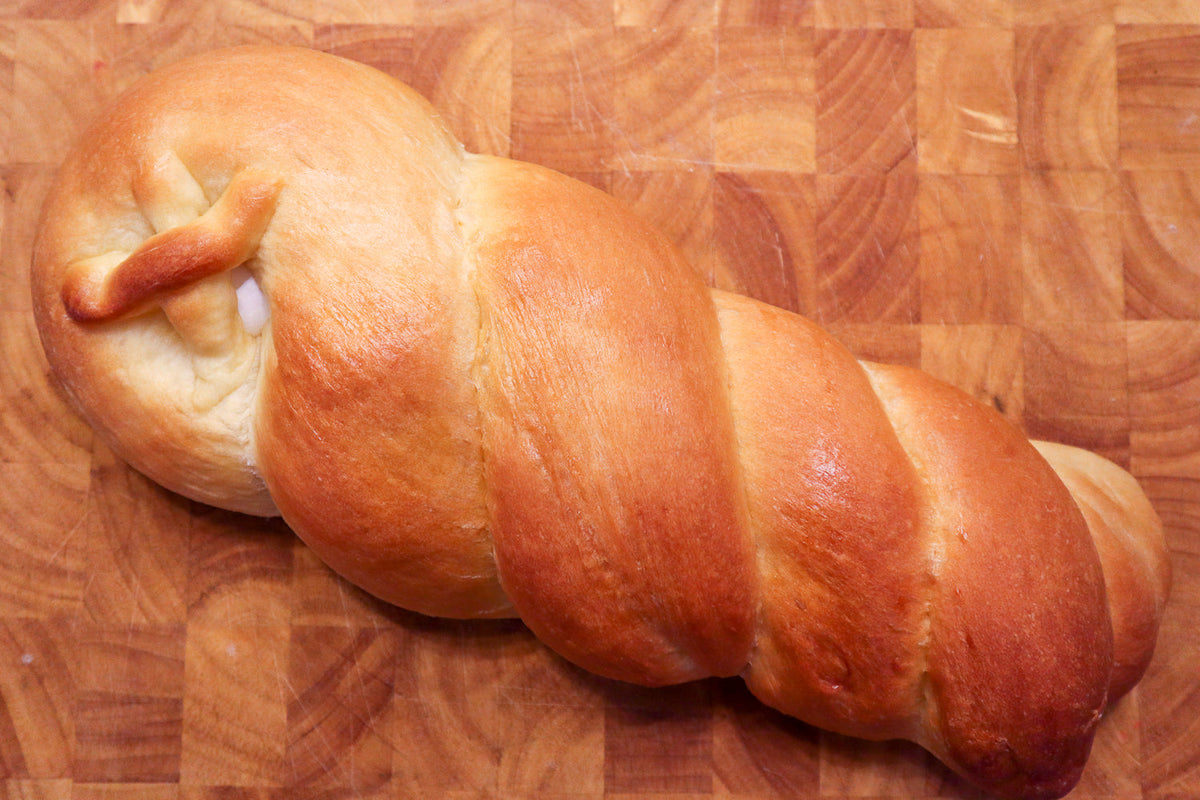
Calabrian Easter Bread
|
|
Time to read 5 min
|
|
Time to read 5 min
Like so many Italian grandmas of her generation, my Nonna Rita was a life-long, devout Catholic. She listened to mass once a day, prayed the rosary religiously, and never ate meat on Fridays. She also felt so much joy every spring when she’d make our family a typical recipe from Calabria: cuculi or Easter bread.
When I was a little kid, my Nonna Rita would put on her flower vest apron and prepared the dough in the late afternoon on the Thursday before Good Friday.
As soon as she formed the dough, she’d bless it. Taking a little water on her finger, she made the sign of the cross three times on the surface of the dough while reciting an Italian blessing. The blessing was meant to help the dough rise, just like Jesus rose from the dead on Easter Sunday. The Italian blessing is now lost to history, but in its place, we still say (In English) “In the name of the Father, the Son, and the holy spirit” while drawing each sign of the cross on the dough.
Nonna would then cover the dough with warm layers of well-loved tablecloths or blankets and leave it to rise with God watching over.
The fun part came a few hours later. Nanna would uncover the dough and pass my little brother and me some smaller pieces to play with. We’d roll them and form them into little balls, proud of our creations. And Nonna was proud too: once they’d finished rising overnight, she’d put them in the oven with the real Easter bread on the morning of Good Friday so that we could show off our mini Easter buns!
The real Easter bread, however, was beautiful. While there are many possible shapes, my nonna’s signature shape has an egg embedded at the top, with the dough braided downwards. I think it looks as sweet as a swaddled baby (but maybe that’s just me!)
Nonna Rita’s freshly baked Easter bread comes out of the oven looking shiny and golden, and smelling oh-so-sweet. With the softest texture and just a touch of anise, it’s the perfect breakfast on Good Friday or Easter Sunday. Enjoy it with your family!

720 minutes
25 minutes
4 loaves
1 packet (8 grams) active dry yeast
1 cup warm water
1 cup + 1 teaspoon sugar
8 eggs, separated
8 ¼ cups all-purpose flour, sifted
1 cup sunflower oil
½ cup whole or 2% milk
3 teaspoons anisette (or anise flavoring)
About 5-6 additional whole eggs for decoration and egg wash (optional)
1 tablespoon water or milk for egg wash (optional)
In a small bowl, mix the yeast, warm water, and 1 teaspoon sugar. Let stand for 5 minutes or until bubbly.
Heat the milk and oil together in a small saucepan until just warm.
Place the egg whites in a large mixing bowl and the yolks in a small mixing bowl. Beat the egg whites with a mixer. Separately, beat the egg yolks with the mixer.
Add the yolks in with the whites and beat them together until incorporated. Beat in the anisette and cup of sugar.
Pour in the warm oil and milk to the egg mixture and beat together. Then, mix in the yeast and water.
Add the sifted flour one cup at a time and mix by hand. After mixing thoroughly, the dough should come together as a smooth and slightly sticky ball.
BONUS STEP: At this point, you can optionally bless the dough by putting water on your finger and making the sign of the cross on it three times.
Leaving the dough in its mixing bowl, cover it in several layers of tablecloths or with a clean blanket for warmth. Let it rise for 3 hours.
Put a little extra flour on the surface where you’ll be rolling out the dough so it doesn’t stick to the surface.
Separate the dough into 4 pieces of equal size. This will give you 4 loaves of bread.
Place your dough shapes on a baking tray covered in parchment paper. Lightly place another layer of parchment paper over the dough, then cover again with several layers of tablecloths or a clean blanket.
Leave the dough to rise for another 8 hours. If leaving overnight, be sure not to let more than 8 hours pass or the dough can become hard.
After letting the dough rise for 8 hours and it has nearly doubled in size, remove all its coverings.
Preheat the oven to 325°F.
You can choose to brush the shapes with an egg wash. (This will make your bread shiny and more golden). To make the egg wash, crack one large egg into a bowl and beat with a fork until it’s a liquid consistency. Add a tablespoon of milk or water, then beat well until incorporated.
Place the baking trays in the oven and let bake for 20-25 minutes or until golden brown on the top and bottom.
Let cool and then enjoy!
Eat your Easter bread within one week of baking — if it lasts that long! Cover in plastic wrap to maintain its freshness. You can store the bread in the freezer for up to a month.

